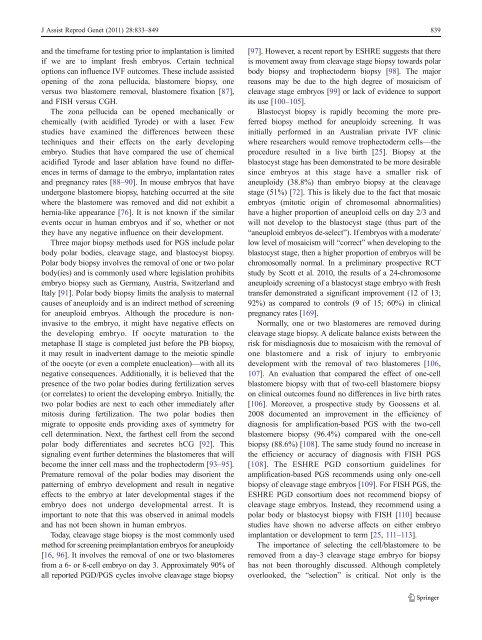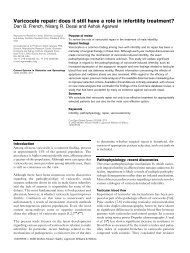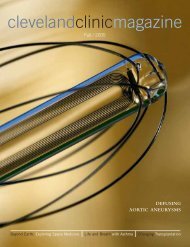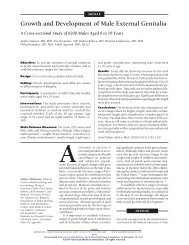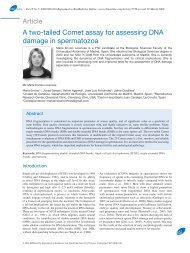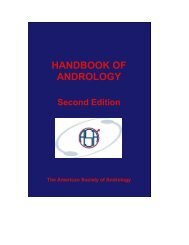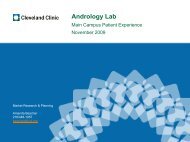Preimplantation genetic screening: does it help or ... - ResearchGate
Preimplantation genetic screening: does it help or ... - ResearchGate
Preimplantation genetic screening: does it help or ... - ResearchGate
You also want an ePaper? Increase the reach of your titles
YUMPU automatically turns print PDFs into web optimized ePapers that Google loves.
J Assist Reprod Genet (2011) 28:833–849 839<br />
and the timeframe f<strong>or</strong> testing pri<strong>or</strong> to implantation is lim<strong>it</strong>ed<br />
if we are to implant fresh embryos. Certain technical<br />
options can influence IVF outcomes. These include assisted<br />
opening of the zona pellucida, blastomere biopsy, one<br />
versus two blastomere removal, blastomere fixation [87],<br />
and FISH versus CGH.<br />
The zona pellucida can be opened mechanically <strong>or</strong><br />
chemically (w<strong>it</strong>h acidified Tyrode) <strong>or</strong> w<strong>it</strong>h a laser. Few<br />
studies have examined the differences between these<br />
techniques and their effects on the early developing<br />
embryo. Studies that have compared the use of chemical<br />
acidified Tyrode and laser ablation have found no differences<br />
in terms of damage to the embryo, implantation rates<br />
and pregnancy rates [88–90]. In mouse embryos that have<br />
undergone blastomere biopsy, hatching occurred at the s<strong>it</strong>e<br />
where the blastomere was removed and did not exhib<strong>it</strong> a<br />
hernia-like appearance [76]. It is not known if the similar<br />
events occur in human embryos and if so, whether <strong>or</strong> not<br />
they have any negative influence on their development.<br />
Three maj<strong>or</strong> biopsy methods used f<strong>or</strong> PGS include polar<br />
body polar bodies, cleavage stage, and blastocyst biopsy.<br />
Polar body biopsy involves the removal of one <strong>or</strong> two polar<br />
body(ies) and is commonly used where legislation prohib<strong>it</strong>s<br />
embryo biopsy such as Germany, Austria, Sw<strong>it</strong>zerland and<br />
Italy [91]. Polar body biopsy lim<strong>it</strong>s the analysis to maternal<br />
causes of aneuploidy and is an indirect method of <strong>screening</strong><br />
f<strong>or</strong> aneuploid embryos. Although the procedure is noninvasive<br />
to the embryo, <strong>it</strong> might have negative effects on<br />
the developing embryo. If oocyte maturation to the<br />
metaphase II stage is completed just bef<strong>or</strong>e the PB biopsy,<br />
<strong>it</strong> may result in inadvertent damage to the meiotic spindle<br />
of the oocyte (<strong>or</strong> even a complete enucleation)—w<strong>it</strong>h all <strong>it</strong>s<br />
negative consequences. Add<strong>it</strong>ionally, <strong>it</strong> is believed that the<br />
presence of the two polar bodies during fertilization serves<br />
(<strong>or</strong> c<strong>or</strong>relates) to <strong>or</strong>ient the developing embryo. In<strong>it</strong>ially, the<br />
two polar bodies are next to each other immediately after<br />
m<strong>it</strong>osis during fertilization. The two polar bodies then<br />
migrate to oppos<strong>it</strong>e ends providing axes of symmetry f<strong>or</strong><br />
cell determination. Next, the farthest cell from the second<br />
polar body differentiates and secretes hCG [92]. This<br />
signaling event further determines the blastomeres that will<br />
become the inner cell mass and the trophectoderm [93–95].<br />
Premature removal of the polar bodies may dis<strong>or</strong>ient the<br />
patterning of embryo development and result in negative<br />
effects to the embryo at later developmental stages if the<br />
embryo <strong>does</strong> not undergo developmental arrest. It is<br />
imp<strong>or</strong>tant to note that this was observed in animal models<br />
and has not been shown in human embryos.<br />
Today, cleavage stage biopsy is the most commonly used<br />
method f<strong>or</strong> <strong>screening</strong> preimplantation embryos f<strong>or</strong> aneuploidy<br />
[16, 96]. It involves the removal of one <strong>or</strong> two blastomeres<br />
from a 6- <strong>or</strong> 8-cell embryo on day 3. Approximately 90% of<br />
all rep<strong>or</strong>ted PGD/PGS cycles involve cleavage stage biopsy<br />
[97]. However, a recent rep<strong>or</strong>t by ESHRE suggests that there<br />
is movement away from cleavage stage biopsy towards polar<br />
body biopsy and trophectoderm biopsy [98]. The maj<strong>or</strong><br />
reasons may be due to the high degree of mosaicism of<br />
cleavage stage embryos [99] <strong>or</strong>lackofevidencetosupp<strong>or</strong>t<br />
<strong>it</strong>s use [100–105].<br />
Blastocyst biopsy is rapidly becoming the m<strong>or</strong>e preferred<br />
biopsy method f<strong>or</strong> aneuploidy <strong>screening</strong>. It was<br />
in<strong>it</strong>ially perf<strong>or</strong>med in an Australian private IVF clinic<br />
where researchers would remove trophectoderm cells—the<br />
procedure resulted in a live birth [25]. Biopsy at the<br />
blastocyst stage has been demonstrated to be m<strong>or</strong>e desirable<br />
since embryos at this stage have a smaller risk of<br />
aneuploidy (38.8%) than embryo biopsy at the cleavage<br />
stage (51%) [72]. This is likely due to the fact that mosaic<br />
embryos (m<strong>it</strong>otic <strong>or</strong>igin of chromosomal abn<strong>or</strong>mal<strong>it</strong>ies)<br />
have a higher prop<strong>or</strong>tion of aneuploid cells on day 2/3 and<br />
will not develop to the blastocyst stage (thus part of the<br />
“aneuploid embryos de-select”). If embryos w<strong>it</strong>h a moderate/<br />
low level of mosaicism will “c<strong>or</strong>rect” when developing to the<br />
blastocyst stage, then a higher prop<strong>or</strong>tion of embryos will be<br />
chromosomally n<strong>or</strong>mal. In a preliminary prospective RCT<br />
study by Scott et al. 2010, the results of a 24-chromosome<br />
aneuploidy <strong>screening</strong> of a blastocyst stage embryo w<strong>it</strong>h fresh<br />
transfer demonstrated a significant improvement (12 of 13;<br />
92%) as compared to controls (9 of 15; 60%) in clinical<br />
pregnancy rates [169].<br />
N<strong>or</strong>mally, one <strong>or</strong> two blastomeres are removed during<br />
cleavage stage biopsy. A delicate balance exists between the<br />
risk f<strong>or</strong> misdiagnosis due to mosaicism w<strong>it</strong>h the removal of<br />
one blastomere and a risk of injury to embryonic<br />
development w<strong>it</strong>h the removal of two blastomeres [106,<br />
107]. An evaluation that compared the effect of one-cell<br />
blastomere biopsy w<strong>it</strong>h that of two-cell blastomere biopsy<br />
on clinical outcomes found no differences in live birth rates<br />
[106]. M<strong>or</strong>eover, a prospective study by Goossens et al.<br />
2008 documented an improvement in the efficiency of<br />
diagnosis f<strong>or</strong> amplification-based PGS w<strong>it</strong>h the two-cell<br />
blastomere biopsy (96.4%) compared w<strong>it</strong>h the one-cell<br />
biopsy (88.6%) [108]. The same study found no increase in<br />
the efficiency <strong>or</strong> accuracy of diagnosis w<strong>it</strong>h FISH PGS<br />
[108]. The ESHRE PGD cons<strong>or</strong>tium guidelines f<strong>or</strong><br />
amplification-based PGS recommends using only one-cell<br />
biopsy of cleavage stage embryos [109]. F<strong>or</strong> FISH PGS, the<br />
ESHRE PGD cons<strong>or</strong>tium <strong>does</strong> not recommend biopsy of<br />
cleavage stage embryos. Instead, they recommend using a<br />
polar body <strong>or</strong> blastocyst biopsy w<strong>it</strong>h FISH [110] because<br />
studies have shown no adverse affects on e<strong>it</strong>her embryo<br />
implantation <strong>or</strong> development to term [25, 111–113].<br />
The imp<strong>or</strong>tance of selecting the cell/blastomere to be<br />
removed from a day-3 cleavage stage embryo f<strong>or</strong> biopsy<br />
has not been th<strong>or</strong>oughly discussed. Although completely<br />
overlooked, the “selection” is cr<strong>it</strong>ical. Not only is the


